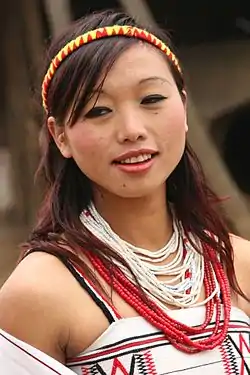Kom people (Manipur)
The Kom are one of the tribes in a family of people called the "Kom-rem" mainly found in Manipur and a plenty in Mizoram of North-East India [1] Koms are also known as the Old Kukis by the Britishers for their own administrative convenience. They are scattered over all the districts of Manipur and settled mainly in the adjoining areas of Manipur valley and hills. Even though they are referred as "Kom", among them they refer to themselves as Kakom. Kom-rem consist of 6 Sub Tribes such as Chiru, Aimol , Kharam, Purum, Koireng and Kom. Kom-rem are found in the Northeastern states of Manipur and Tripura. The majority of the Kom population reside in Manipur. They are found in almost all the districts of Manipur and concentrated mainly in the districts of Churachandpur, Bishnupur, Chandel, Kangpokpi, Tengnoupal, Thoubal, Kakching and Senapati.
| Total population | |
|---|---|
| 14,000 | |
| Regions with significant populations | |
| India (Manipur) | |
| Languages | |
| Kom | |
| Religion | |
| Christianity | |
| Related ethnic groups | |
| Hmar · Chiru · Mizo |
According to 2001 Census of India, the population of Kom is 14,602.[2]
Origins
Their origin is unclear as they were nomadic people till they entered Manipur. The location of the cave is believed to be somewhere in the borders of China.Karong (referred also as Shongthu and Puvom), Leivon, Serto, Hmangte, Telen /Thingpui, Khumdon and Mirem ' were the names of the leaders who came out of the cave. The names of these leaders became the Clan names of the Kom people. . These people are referred as Kom by the British Raj. [ needs to be corrected still]
Clan names
The present clan names and their original clan name are as follows:
| Original Name | Present Name |
|---|---|
| Shōngthu | Karōng |
| Saiche | Serto |
| Misai | Leivon |
| Mirem | Lupheng |
| Telien | Telien |
| Hmangte | Hmangte |
Even though the clan names have changed through generations, the elders of each of the main original clans are still among the Kom people. The majority of this community are Christian. Their stories-folklore and legends- are passed down through generations by oral/verbal forms or word of mouth.
Hair Styles (Traditional)
 Kom Girl
Kom Girl Kom Boy
Kom Boy Kom Adult Female
Kom Adult Female Kom Adult Male
Kom Adult Male
References
- Politics and Culture. Bookwell. 2013. p. 90. ISBN 978-9380574448.
- 2001 Census of India. "Population of Schedule Tribes of Manipur"
